Interfacial Bonding and Abrasive Wear Behavior of Iron Matrix Composite Reinforced by Ceramic Particles
Abstract
:1. Introduction
2. Materials and Methods
2.1. Preparation of Composite
2.2. Three-Body Abrasive Wear Tests
3. Results and Discussion
3.1. The Structure of ZTA Ceramic Preforms
3.2. Analysis of Composite Interface
3.3. Wear Resistance of the Composite
4. Conclusions
Author Contributions
Funding
Conflicts of Interest
References
- Rosso, M. Ceramic and metal matrix composites: Routes and properties. J. Mater. Process Technol. 2006, 175, 364–375. [Google Scholar] [CrossRef]
- Cardarelli, F. Materials Handbook, 2nd ed.; Springer: London, UK, 2008. [Google Scholar]
- Schaffer, J.; Saxena, A.; Antolovich, S.D.; Sanders, T.H., Jr.; Warner, S.B. The Science and Design of Engineering Materials, 2nd ed.; McGraw-Hill Companies Inc.: New York, NY, USA, 1999. [Google Scholar]
- Czuprynski, A. Properties of Al2O3/TiO2 and ZrO2 and ZrO2/CaO flame sprayed coatings. Mater. Technol. 2017, 51, 205–212. [Google Scholar]
- Tang, S.L.; Gao, Y.M.; Li, Y.F. Recent developments in fabrication of ceramic particle reinforced iron matrix wear resistant surface composite using infiltration casting technology. Ironmak. Steelmak. 2014, 41, 633–640. [Google Scholar] [CrossRef]
- Czuprynski, A. Flame spraying of aluminum coatings reinforced with particles of carbonaceous materials as an alternative for laser cladding technologies. Materials 2019, 12, 3467. [Google Scholar] [CrossRef] [PubMed]
- Chen, W.; Shi, H.; Xin, H.; He, N.; Yang, W.; Gao, H. Friction and wear properties of Si3N4-hBN ceramic composites using different synthetic lubricants. Ceram. Int. 2018, 44, 16799–16808. [Google Scholar] [CrossRef]
- Gorka, J.; Czuprynski, A.; Zuk, M.; Adamiak, M.; Kopysc, A. Properties and structure of deposited nanocrystalline coatings in relation to selected construction materials resistant to abrasive wear. Materials 2018, 11, 1184. [Google Scholar] [CrossRef] [PubMed]
- Sequeira, S.; Fernandes, M.H.; Neves, N.; Almeida, M.M. Development and characterization of zirconia-alumina composites for orthopedic implants. Ceram. Int. 2016, 43, 693–703. [Google Scholar] [CrossRef]
- Wen, R.L.; Fang, M.H.; Min, X.; Tang, H.; Tang, C.; Wei, Y.Z.; Huang, Z.H.; Liu, Y.H.; Wu, X.W. Effect of ZrO2 addition on mechanical and erosive wear properties of ZTA ceramic. J. Synth. Cryst. 2013, 42, 257–261. [Google Scholar]
- Ganesh, I.; Sundararajan, G.; Olhero, S.M.; Ferreira, J.M.F. Influence of chemical composition on sintering ability of ZTA ceramics consolidated from freeze dried franules. Ceram. Int. 2011, 37, 835–841. [Google Scholar] [CrossRef]
- Esfahani, H.; Nemati, A.; Salahi, E. The effect of composition and sintering conditions on zircoia toughened alumian (ZTA) nanocomposites. Adv. Mater. Res. 2010, 93, 695–698. [Google Scholar] [CrossRef]
- Casellas, D.; Nagl, M.M.; Llanes, L.; Anglada, M. Fracture toughness of alumina and ZTA ceramics: Microstructural coasening effects. J. Mater. Process Technol. 2003, 143, 148–152. [Google Scholar] [CrossRef]
- Kern, F.; Palmero, P. Microstructure and mechanical properties of alumina 5 vol.% zirconia nanocomposites prepared by powder coating and powder mixing routes. Ceram. Int. 2013, 39, 673–682. [Google Scholar] [CrossRef]
- ASM International Handbook Committee. Properties and selection: Irons, steels, and high-performance alloys. In ASM Handbook; ASM International: Geauga, OH, USA, 1993. [Google Scholar]
- Elomari, S.; Boukhili, R.; Lloyd, D.J. Thermal expansion studies of prestrained Al2O3/Al metal matrix composite. Acta Mater. 1996, 44, 1873–1882. [Google Scholar] [CrossRef]
- Tada, H.; Kumpel, A.E.; Lathrop, R.E.; Slanina, J.B.; Niewa, P.; Zavracky, P.; Miaoulis, L.N.; Wong, P.Y. Thermal expansion coefficient of polycrystalline silicon and silicon dioxide thin films at high temperatures. J. Appl. Phys. 2000, 87, 4189. [Google Scholar] [CrossRef]
- Li, Z.; Bradt, R.C. Thermal expansion and thermal expansion anisotropy of SiC polytypes. J. Am. Ceram. Soc. 1987, 70, 445–448. [Google Scholar] [CrossRef]
- Hossen, M.M.; Chowdhury, F.U.Z.; Gafur, M.A.; Abdul Hakim, A.K.M. Structure and mechanical properties of zirconia toughened alumina composites. Int. J. Eng. Res. Tech. 2014, 3, 2128–2134. [Google Scholar]
- Li, J.; Zhang, X.S.; Song, P. Toughening mechanism and thermal shock resistance of ZrO2(3Y)/Fe28at-%Al composites evaluated by indentation techniques. Adv. Appl. Ceram. 2014, 113, 404–410. [Google Scholar] [CrossRef]
- Sui, Y.D.; Zhou, M.J.; Jiang, Y.H. Characterization of interfacial layer of ZTA ceramic particles reinforced iron matrix composites. J. Alloy. Compd. 2018, 741, 1169–1174. [Google Scholar] [CrossRef]
- Zheng, K.H.; Gao, Y.M.; Li, Y.F.; Zhao, S.M.; Wang, J. Three-body abrasive wear resistance of iron matrix composites reinforced with ceramic particles. Proc. Inst. Mech. Eng. Part J 2014, 228, 3–10. [Google Scholar] [CrossRef]
- Bahraini, M.; Minghetti, T.; Zoellig, M.; Schubert, J.; Berroth, K.; Schelle, C.; Graule, T.; Kuebler, J. Activated pressureless infiltration of metal-matrix composites with graded activator content. Comp. Part A 2009, 40, 1566–1572. [Google Scholar] [CrossRef]
- Vasic, S.; Grobety, B.; Kuebler, J.; Kern, P.; Graule, T. Experimental models for activrationmechanisam of pressureless infiltration in the non-wetting steel-alumina MMC system. Adv. Eng. Mater. 2008, 10, 471–475. [Google Scholar] [CrossRef]
- Manonukul, A.; Tange, M.; Srikudvien, P.; Denmud, N.; Wattanapornphan, P. Rheological properties of commercially pure titanium slurry for metallic foam production using replica impregnation method. Powder Technol. 2014, 266, 129–134. [Google Scholar] [CrossRef]
- Choi, J.H.; Yang, S.; Kim, Y.D.; Yun, J.Y. The effect of binder content for the pore properties of Fe foam fabricated by slurry coating process. J. Korean Powder Metall. Inst. 2013, 20, 439–444. [Google Scholar] [CrossRef]
- Rannou, B.; Velasco, F.; Guzman, S.; Kolarik, V.; Pedraza, F. Aging and thermal behavior of a PVA/Al microspheres slurry for aluminizing purposes. Mater. Chem. Phys. 2012, 134, 360–365. [Google Scholar] [CrossRef]
- LeBeau, J.M.; Boonyongmaneerat, Y. Comparison study of aqueous binder systems for slurry-based processing. Mater. Sci. Eng. A 2007, 458, 17–24. [Google Scholar] [CrossRef]
- Chen, H.H.; Xing, J.D.; Li, W. Handbook of Wear Resistant Materials, 2nd ed.; Machine Press: Beijing, China, 2012. [Google Scholar]
- Li, Y.F.; Tang, S.L.; Gao, Y.M.; Ma, S.Q.; Zheng, Q.L.; Cheng, Y.H. Mechanical and thermodynamic properties of intermetallic compounds in the Ni-Ti system. Int. J. Mod. Phys. B 2017, 31, 1750161. [Google Scholar] [CrossRef]
- Chen, Q.; Huang, Z.W.; Zhao, Z.D.; Hu, C.K. First-Principles study on the structural, elastic, and thermodynamics properties of Ni3X (X: Al, Mo, Ti, Pt, Si, Nb, V, and Zr) intermetallic compounds. Appl. Phys. A 2014, 116, 1161. [Google Scholar] [CrossRef]
- Tang, S.L.; Li, Y.F.; Wang, Y.R.; Gao, Y.M.; Zheng, Q.L.; Yi, D.W. Theoretical study of mechanical and thermodynamic properties of titanium oxides TixOy. Mater. Chem. Phys. 2018, 213, 638–647. [Google Scholar] [CrossRef]
- Jiang, B.; Zhou, G.G.; Huang, K.; Hou, J.G.; Jiao, S.Q.; Zhu, H.M. Structural stability of β-TiO with disordered vacancies: A first-principles calculation. Phys. B 2003, 421, 110–116. [Google Scholar] [CrossRef]
- Tang, S.L.; Li, Y.F.; Gao, Y.M.; Zheng, Q.L.; Liu, Z.W.; Ren, Q.Y. First-Principles investigations of the structural, anisotropic mechanical, thermodynamic and electronic properties of the AlNi2Ti compound. Crystals 2018, 8, 93. [Google Scholar] [CrossRef]
- Wen, Z.Q.; Zhao, Y.H.; Hou, H.; Wang, B.; Han, P.D. The mechanical and thermodynamic properties of Heusler compounds Ni2XAl (X = Sc, Ti, V) under pressure and temperature: A first-principles study. Mater. Des. 2017, 114, 398–403. [Google Scholar] [CrossRef]
- Li, Y.F.; Gao, Y.M. Three-Body abrasive wear behavior of CC/high-Cr WCI composite and its interfacial characteristic. Wear 2010, 268, 511–518. [Google Scholar] [CrossRef]
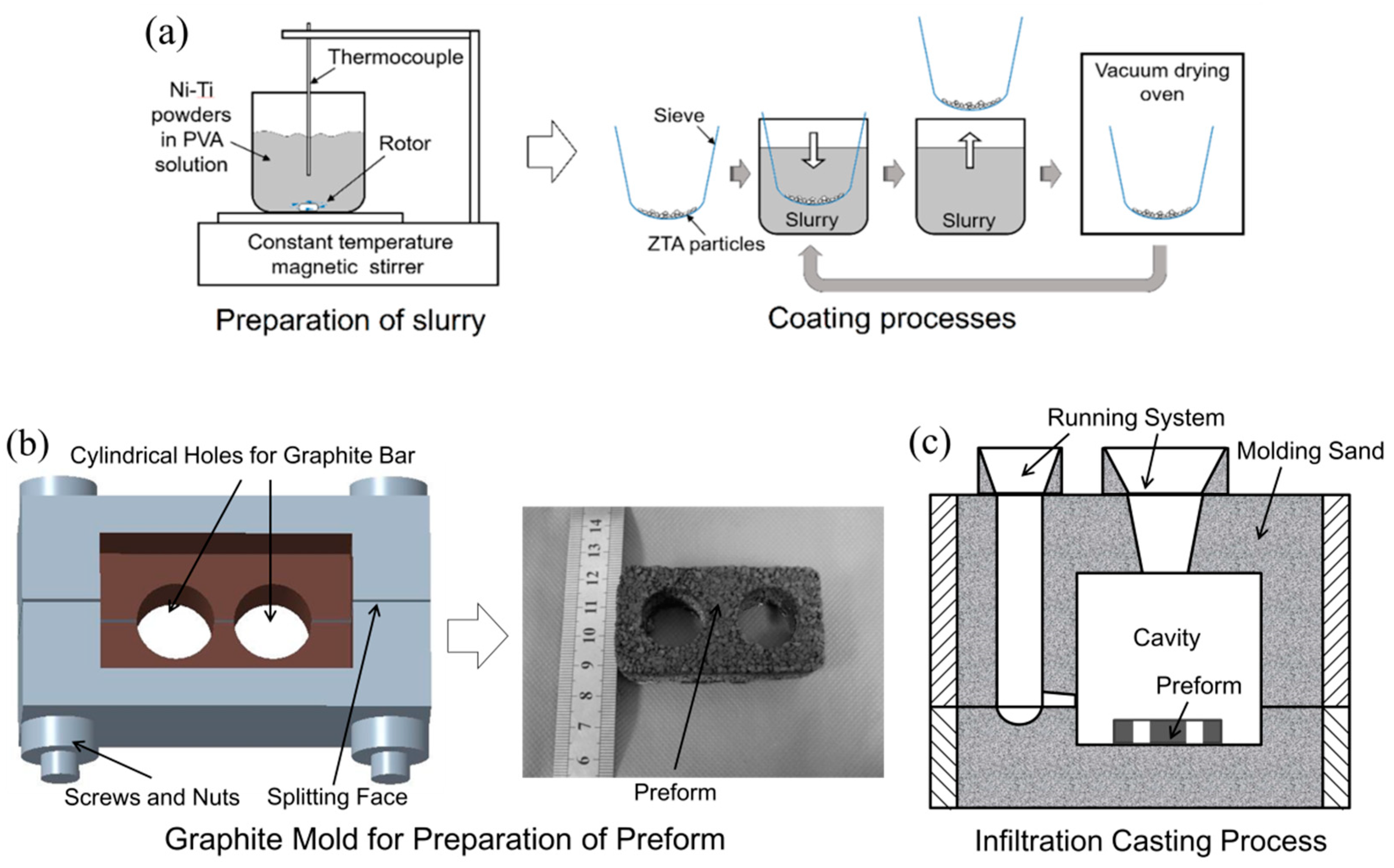
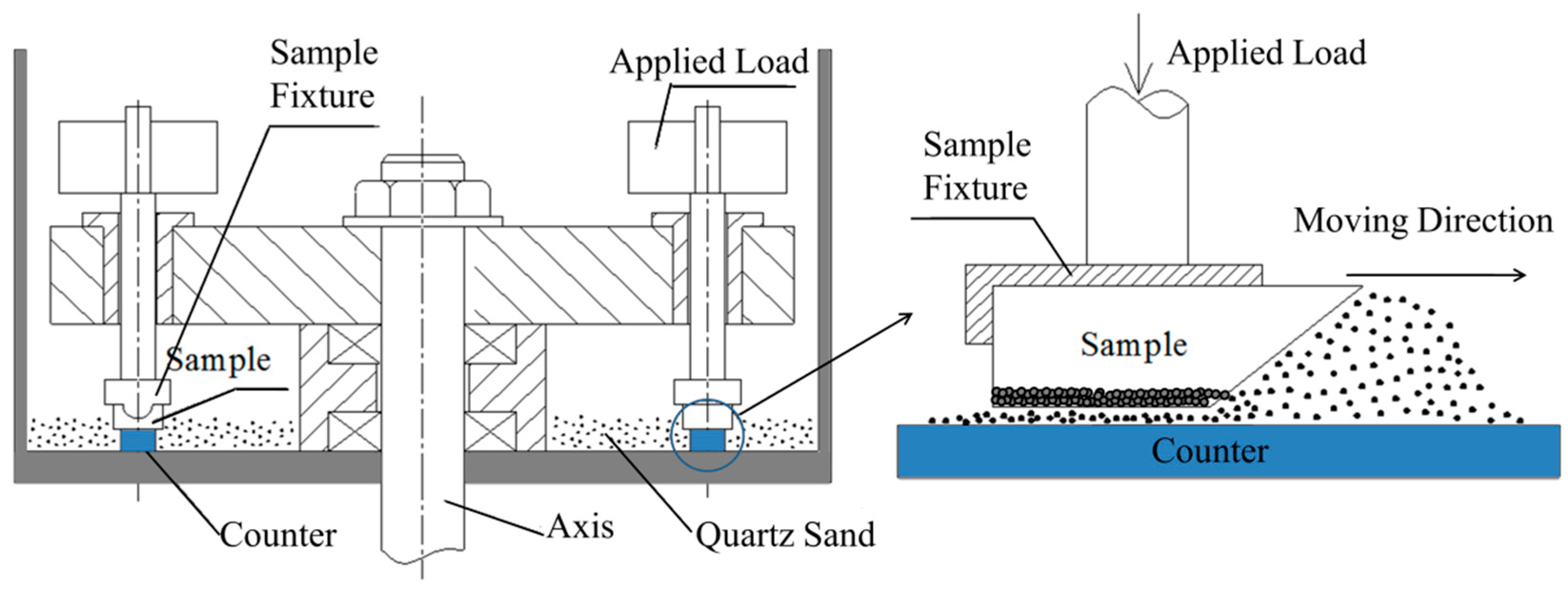
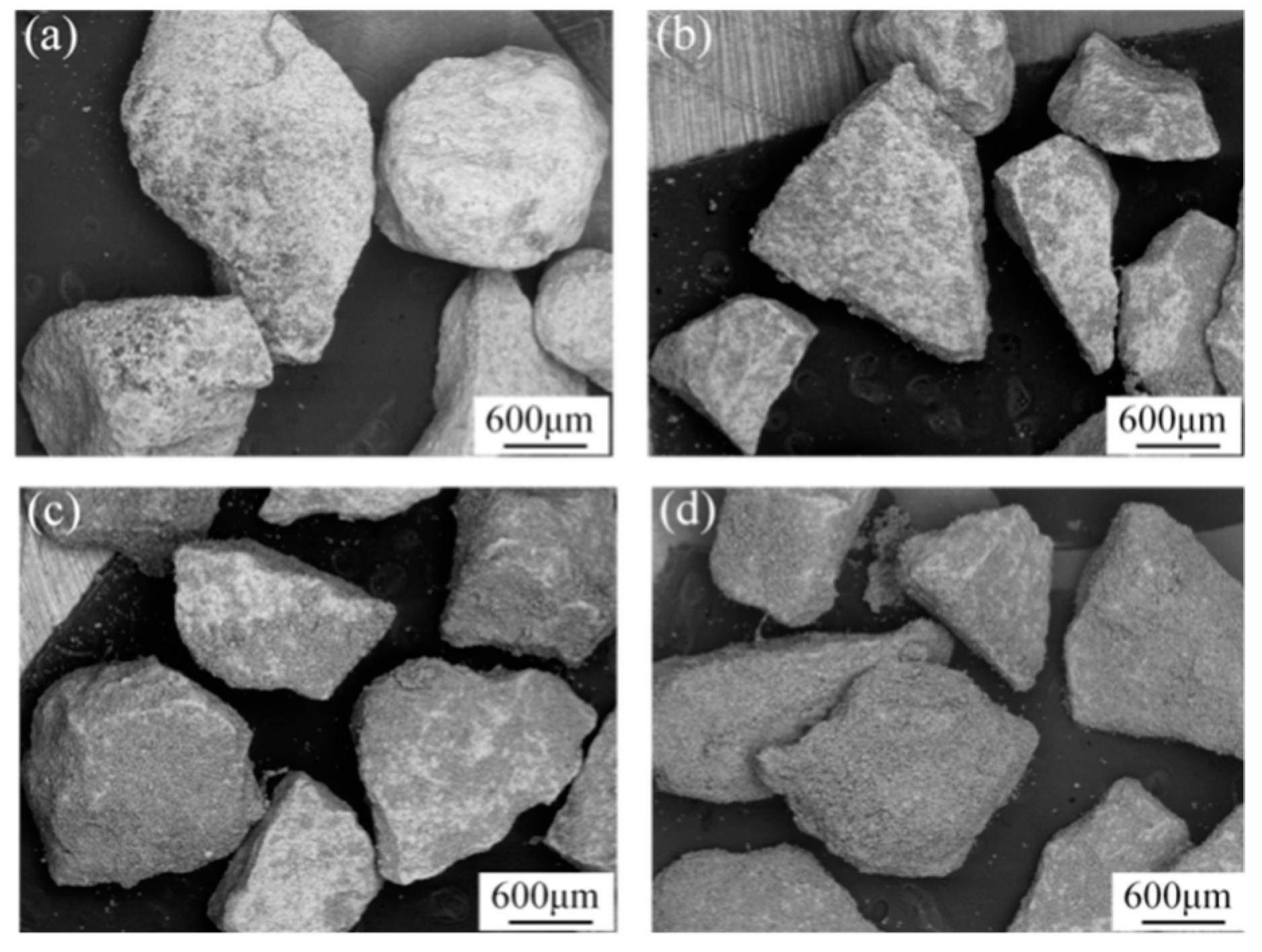
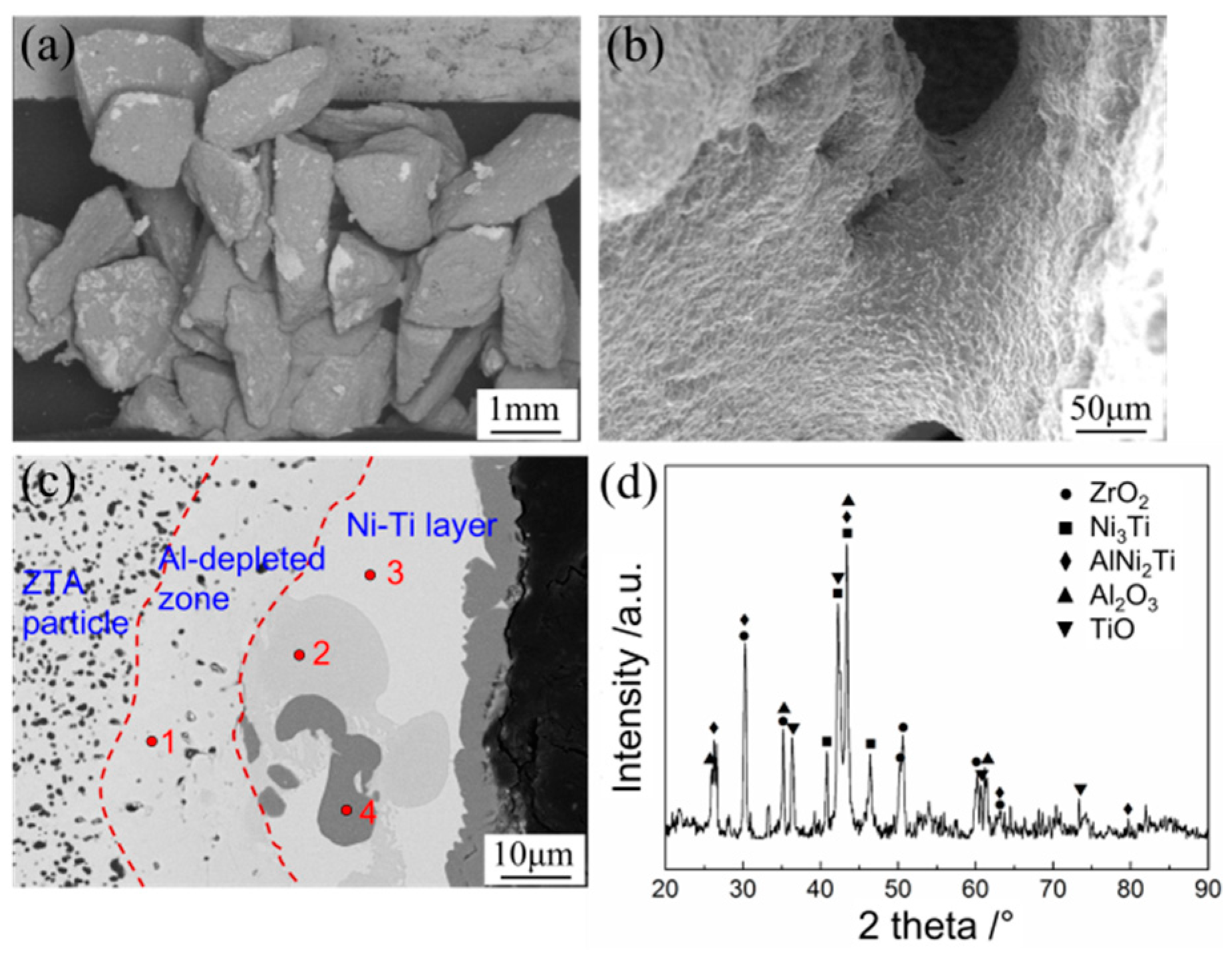
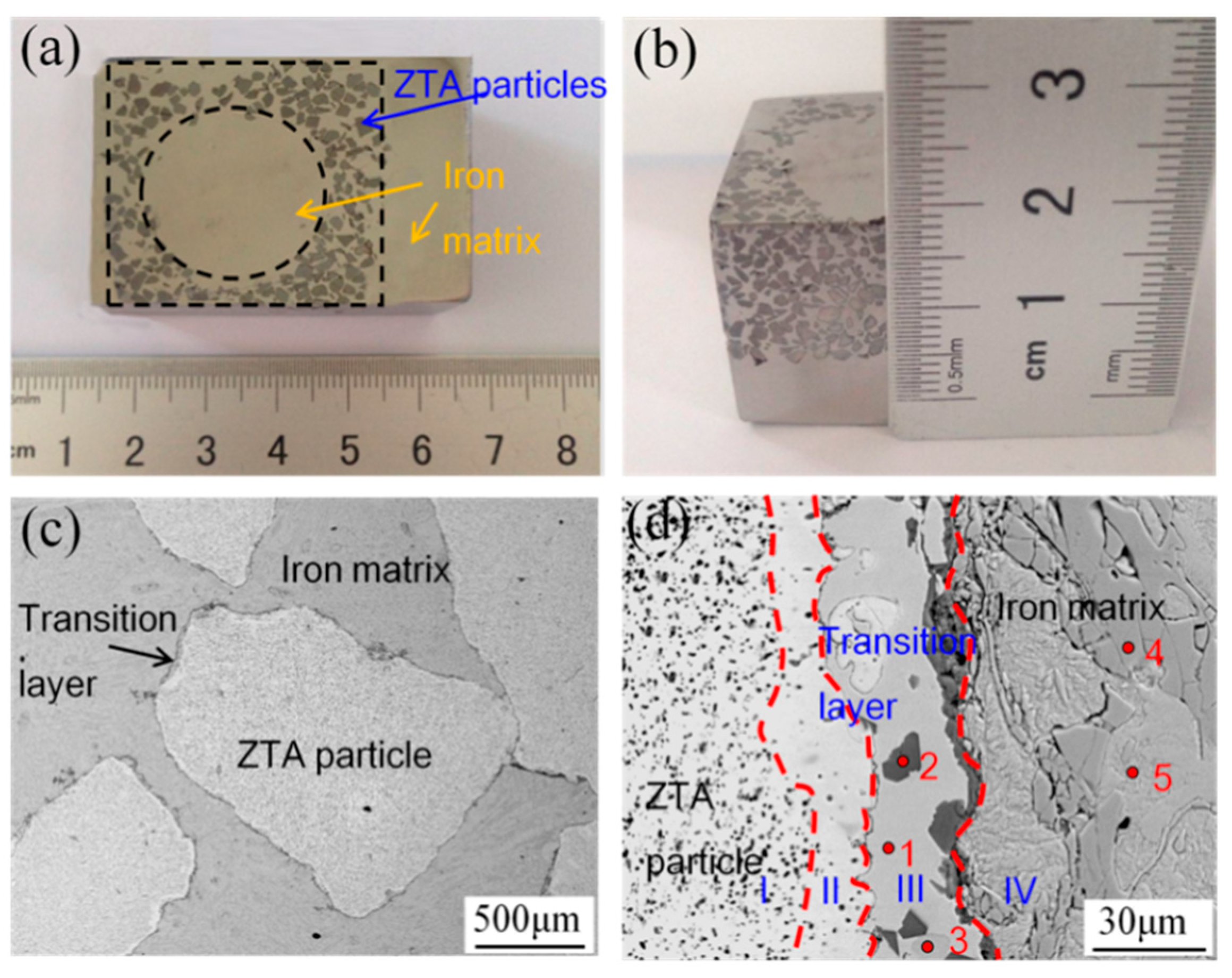
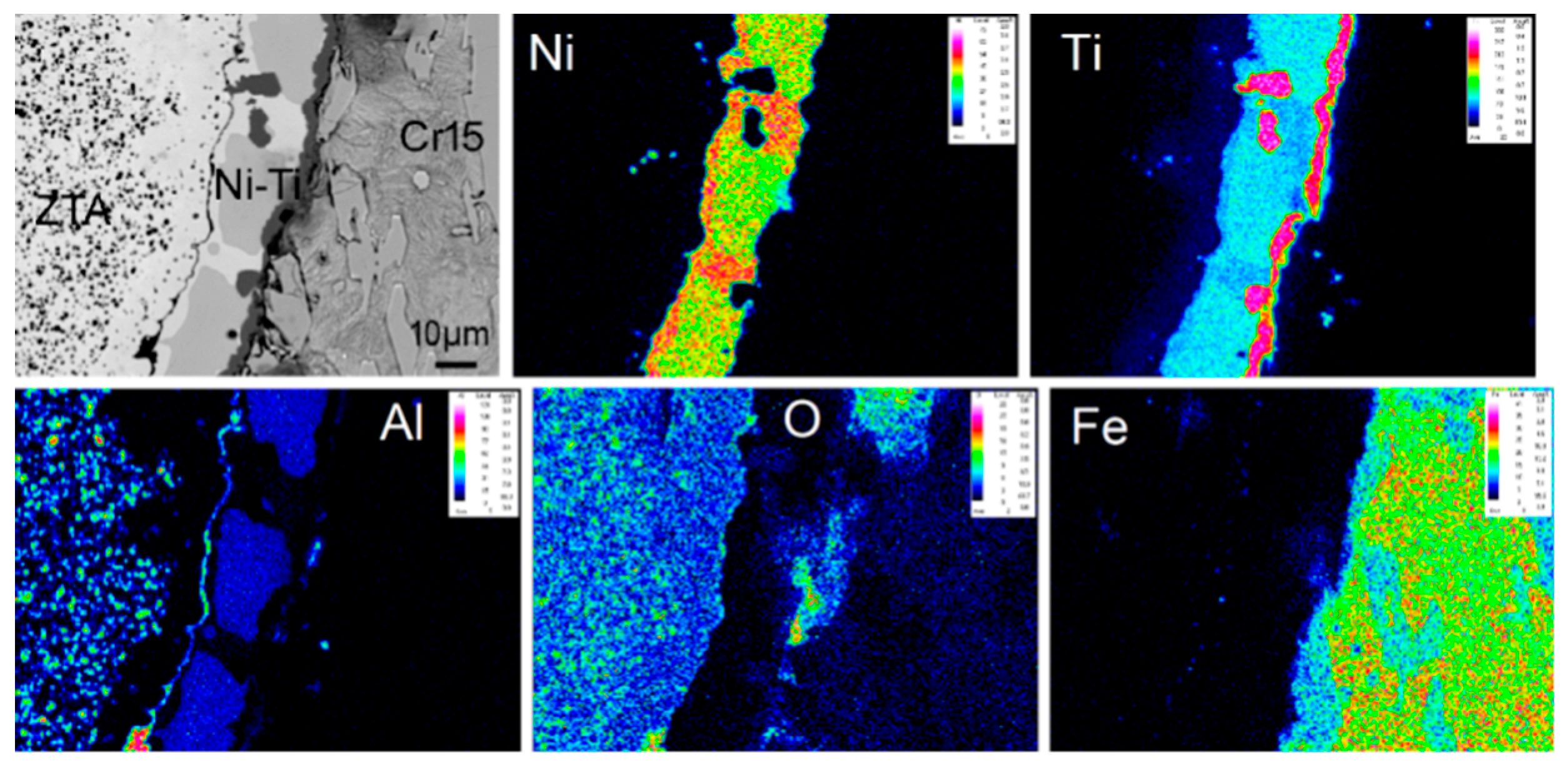

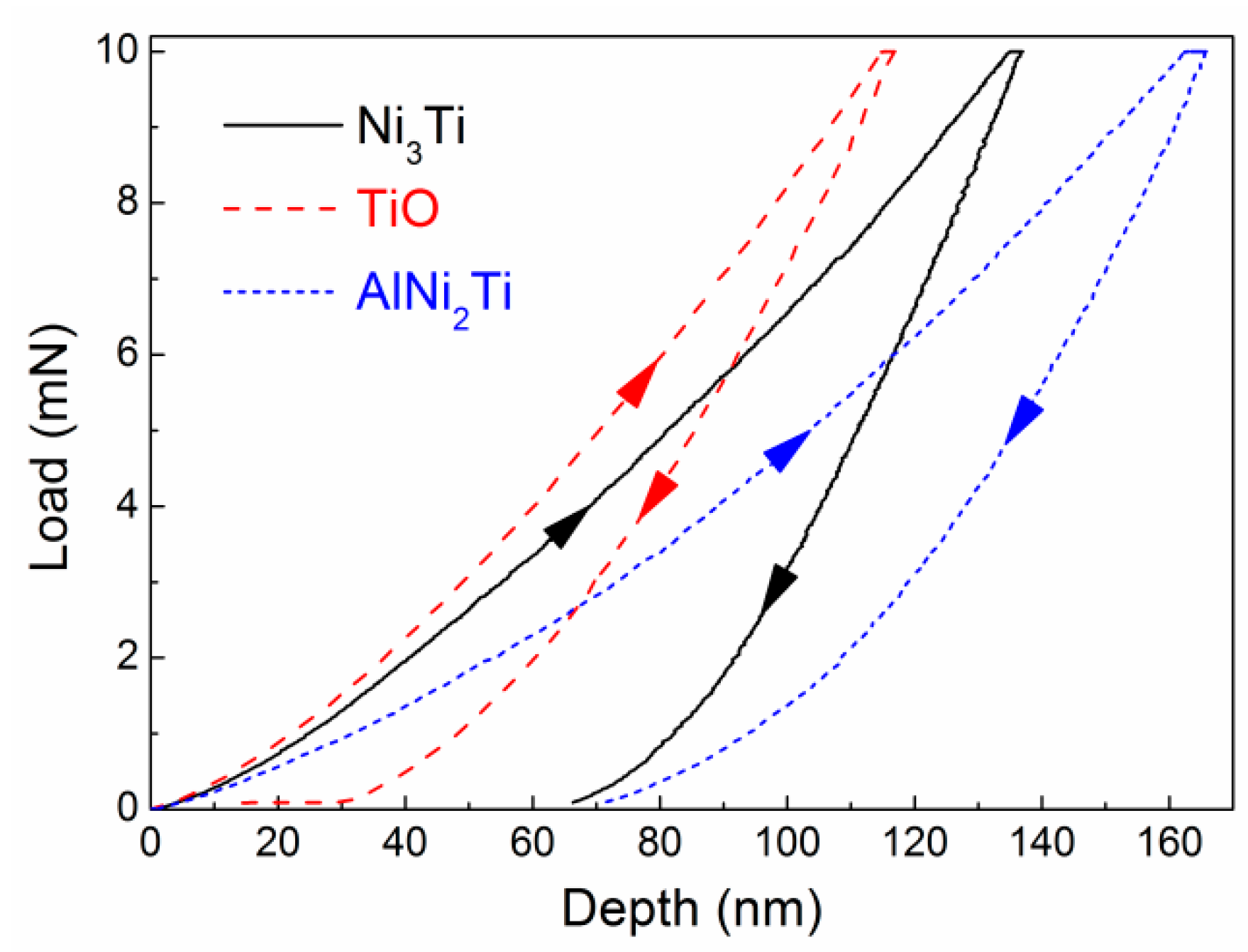
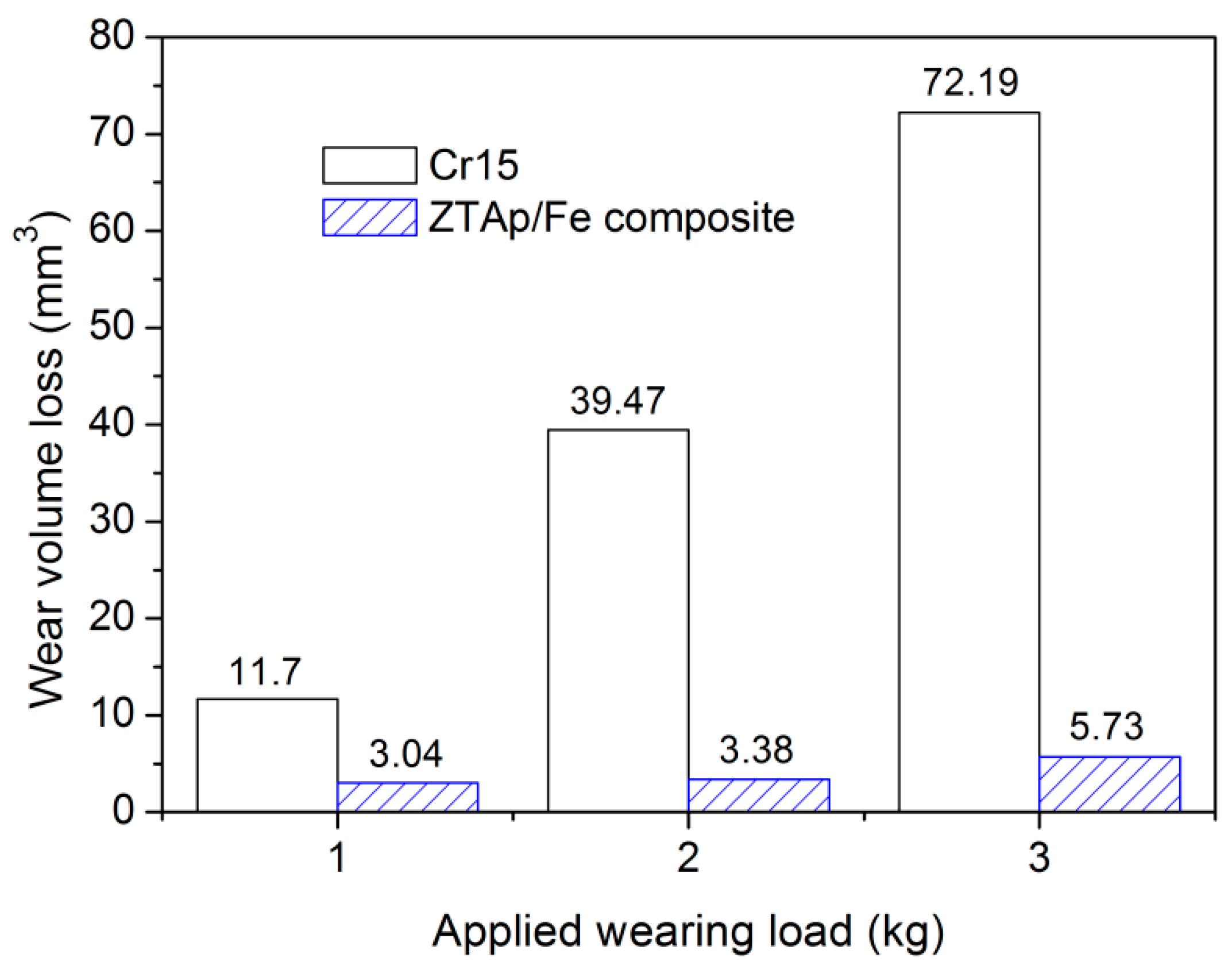
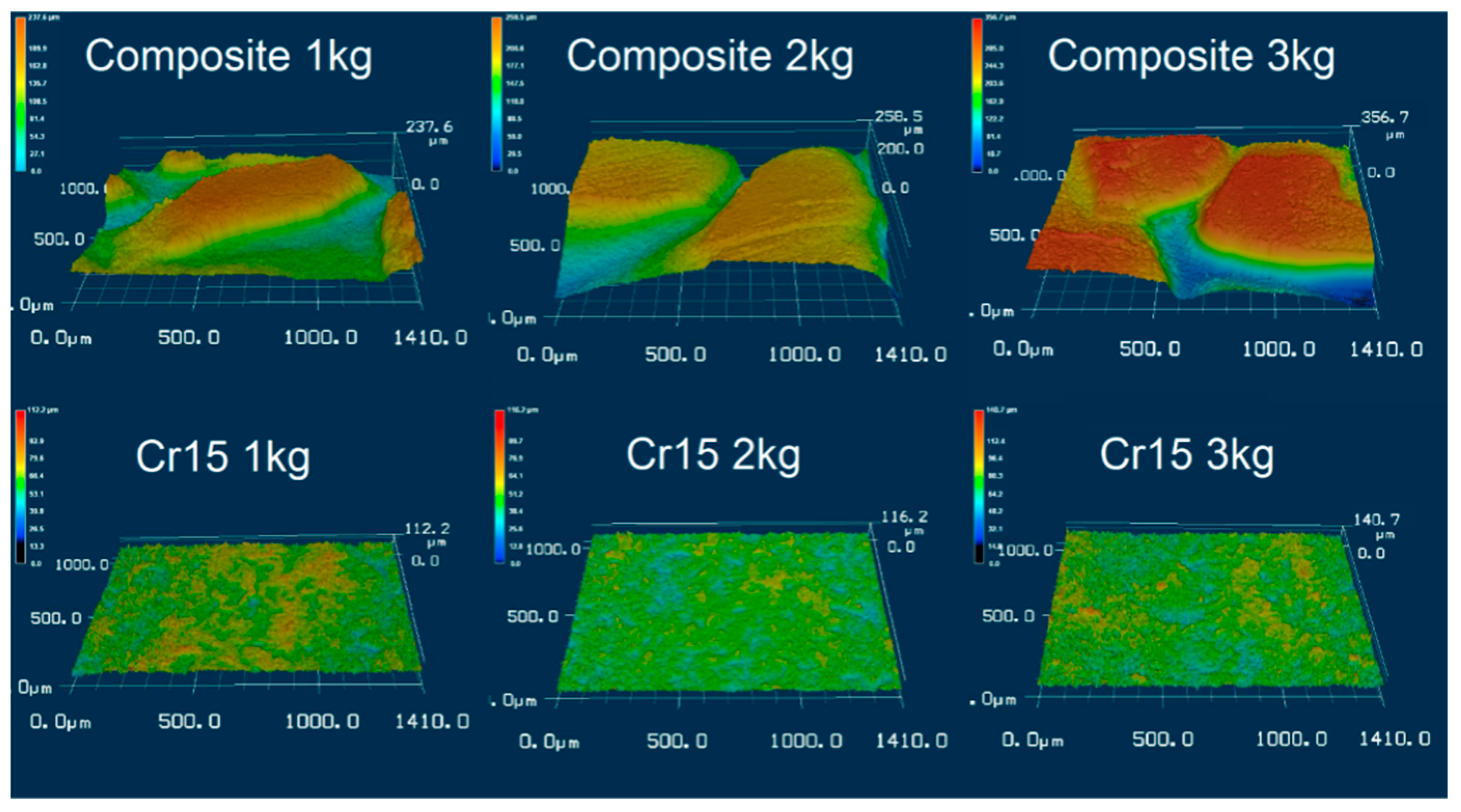
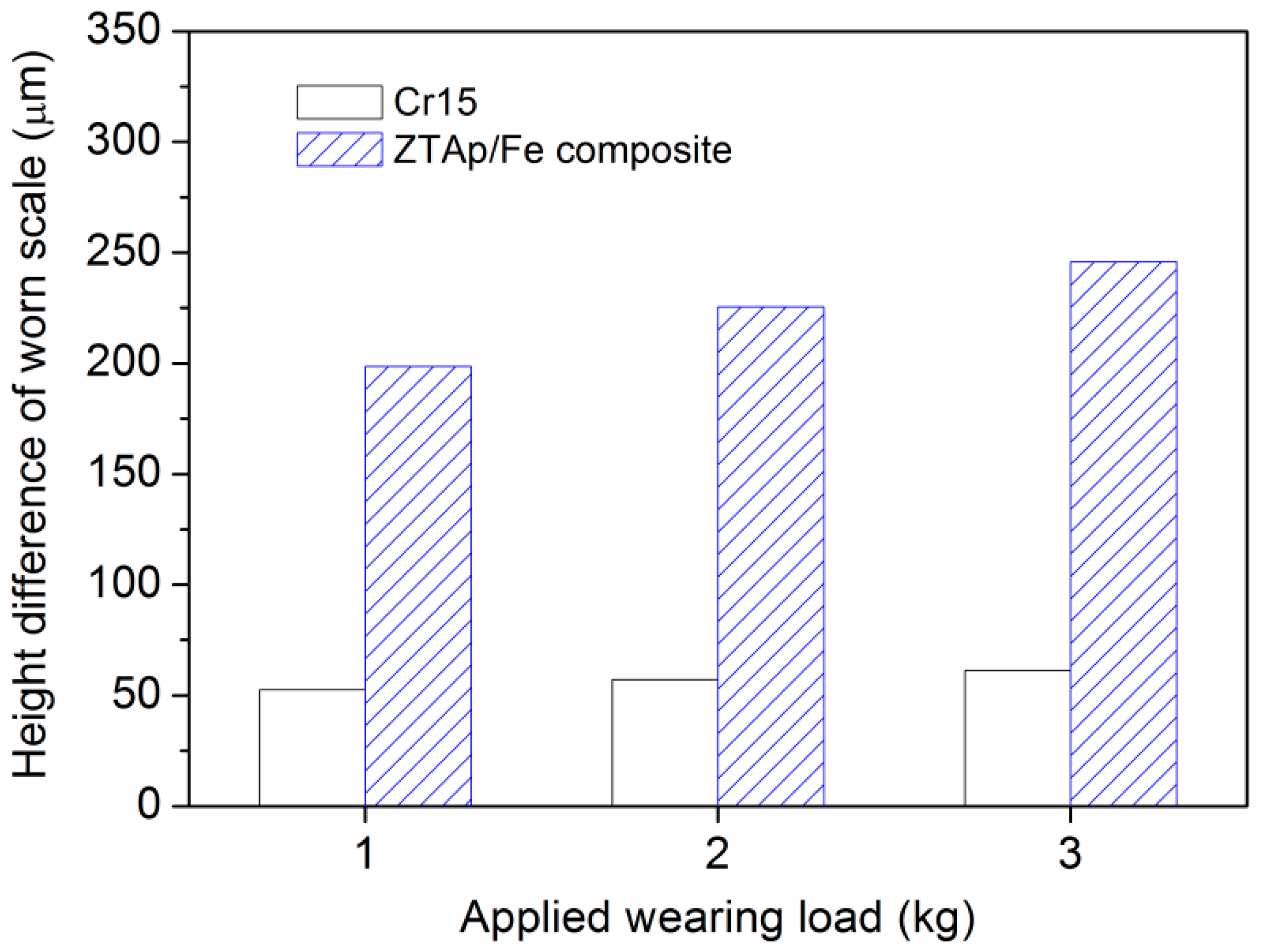
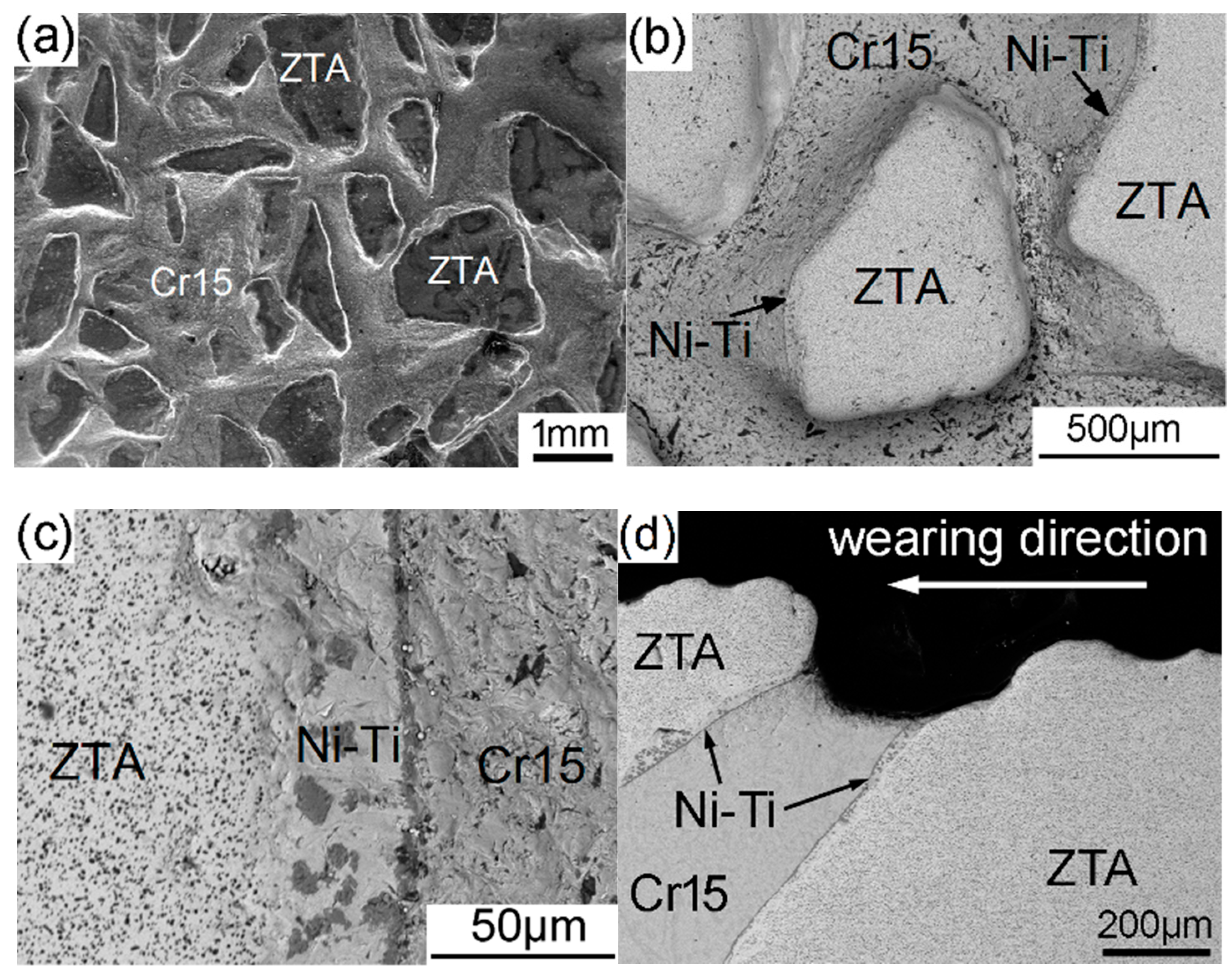
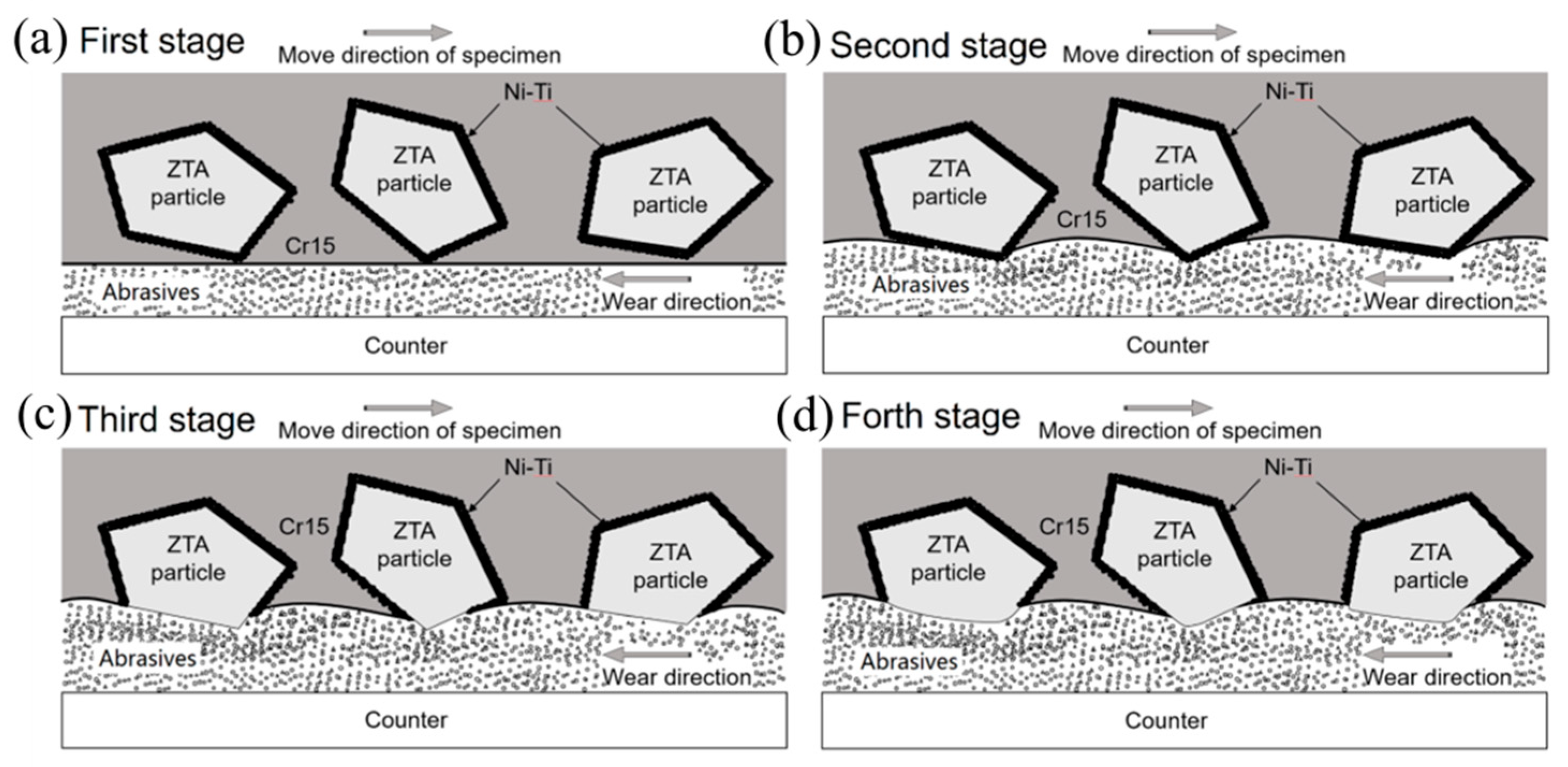
| Point to Be Analyzed | Element | |||||||||
|---|---|---|---|---|---|---|---|---|---|---|
| Ni | Ti | Al | O | Zr | C | Fe | Mn | Cr | ||
| Figure 4c | Point 1 | 3.12 | 53.54 | 43.34 | ||||||
| Point 2 | 56.57 | 22.67 | 20.76 | |||||||
| Point 3 | 74.39 | 25.61 | ||||||||
| Point 4 | 0.75 | 86.07 | 13.18 | |||||||
| Figure 5d | Point 1 | 71.56 | 13.86 | 8.73 | 0.22 | 4.90 | 0.73 | |||
| Point 2 | 1.42 | 54.83 | 42.87 | 0.88 | ||||||
| Point 3 | 54.28 | 14.56 | 17.22 | 0.16 | 9.41 | 1.66 | 2.71 | |||
| Point 4 | 1.04 | 43.55 | 1.81 | 53.60 | ||||||
| Point 5 | 0.76 | 0.51 | 85.83 | 4.43 | 8.47 | |||||
| Phases | Young’s Modulus/GPa | Micro-Hardness/GPa |
|---|---|---|
| Ni3Ti | 211 (253a, 260b) | 12.5 (10.5a) |
| TiO | 225 (267c) | 16.1 (14.3d) |
| AlNi2Ti | 165 (178.1e) | 9.2 (8.1f) |
© 2019 by the authors. Licensee MDPI, Basel, Switzerland. This article is an open access article distributed under the terms and conditions of the Creative Commons Attribution (CC BY) license (http://creativecommons.org/licenses/by/4.0/).
Share and Cite
Li, Y.; Li, C.; Tang, S.; Zheng, Q.; Wang, J.; Zhang, Z.; Wang, Z. Interfacial Bonding and Abrasive Wear Behavior of Iron Matrix Composite Reinforced by Ceramic Particles. Materials 2019, 12, 3646. https://doi.org/10.3390/ma12223646
Li Y, Li C, Tang S, Zheng Q, Wang J, Zhang Z, Wang Z. Interfacial Bonding and Abrasive Wear Behavior of Iron Matrix Composite Reinforced by Ceramic Particles. Materials. 2019; 12(22):3646. https://doi.org/10.3390/ma12223646
Chicago/Turabian StyleLi, Yefei, Cong Li, Shuli Tang, Qiaoling Zheng, Juan Wang, Zhibo Zhang, and Zhicheng Wang. 2019. "Interfacial Bonding and Abrasive Wear Behavior of Iron Matrix Composite Reinforced by Ceramic Particles" Materials 12, no. 22: 3646. https://doi.org/10.3390/ma12223646
APA StyleLi, Y., Li, C., Tang, S., Zheng, Q., Wang, J., Zhang, Z., & Wang, Z. (2019). Interfacial Bonding and Abrasive Wear Behavior of Iron Matrix Composite Reinforced by Ceramic Particles. Materials, 12(22), 3646. https://doi.org/10.3390/ma12223646





